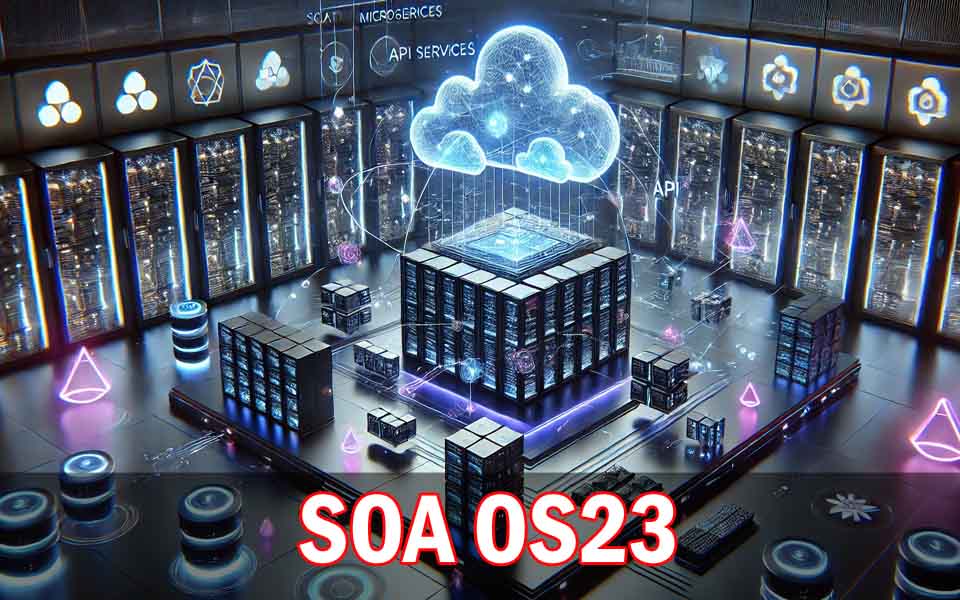SOA OS23: The Future of Scalable Service Architecture

What is SOA OS23?
SOA OS23 stands for the latest release in a line of open-source or enterprise-oriented platforms based on the Service-Oriented Architecture (SOA) model. Unlike monolithic systems, SOA OS23 structures applications as a suite of interoperable services — each self-contained, reusable, and loosely coupled.
This platform represents a significant evolution from traditional SOA systems by integrating modern technologies such as containerization, API gateways, microservices orchestration, and real-time messaging. Designed for flexibility and rapid deployment, soa os23 is ideal for cloud-native environments and hybrid enterprise infrastructures.
Core Features of SOA OS23
Microservices-Ready Architecture
Break down applications into smaller, manageable units. Each service can be updated, deployed, or scaled independently.
Seamless API Integration
SOA OS23 provides built-in support for REST, GraphQL, SOAP, and other protocols. Its API gateway enables smooth communication between internal and external systems.
Multi-Environment Support
Whether you’re deploying on Kubernetes, Docker, or bare metal, soa os23 adapts easily to diverse infrastructures.
Intelligent Service Orchestration
Coordinate multiple services in real-time using configurable rules and workflows. Automation and service chaining are native to the platform.
Built-in Observability Tools
Monitor service health, latency, and usage metrics using integrated dashboards and alerts. Supports OpenTelemetry for advanced tracing.
Benefits of Using SOA OS23

- Faster Time-to-Market: Modular services allow faster development and iterative releases.
- Improved Fault Tolerance: Issues in one service don’t cripple the entire system.
- Cost Efficiency: Scalable infrastructure means you only use resources where needed.
- Enhanced Team Collaboration: Teams can work independently on different services.
- Better Security Posture: Isolated services reduce the risk of large-scale breaches.
SOA OS23 Use Cases and Applications
SOA OS23 is not limited to any single industry. Its modularity and scalability make it ideal for sectors such as:
- Finance: Real-time transaction processing and fraud detection
- Healthcare: Secure patient data systems and regulatory compliance
- Logistics: Real-time tracking and dispatch systems
- Telecommunications: Dynamic service provisioning and billing engines
Comparison: SOA OS23 vs Traditional SOA Frameworks
| Feature | SOA OS23 | Traditional SOA |
|---|---|---|
| Microservices support | ✅ Yes | ❌ No |
| Container-native architecture | ✅ Yes | ❌ No |
| API-first design | ✅ Yes | ⚠️ Limited |
| Real-time orchestration | ✅ Built-in | ❌ Requires add-ons |
| DevOps compatibility | ✅ Seamless | ⚠️ Manual setup |
Installation and Getting Started with SOA OS23
- System Requirements: 8GB+ RAM, Docker, Ubuntu or Unix OS
- Installation: Clone the repo or use the official installer script
- Configuration: Customize the service registry, authentication, and DB connectors
- Launch: Access orchestration dashboard and begin registering services
Security and Compliance in SOA OS23
Security is embedded throughout SOA OS23:
- OAuth2 and JWT authentication support
- Role-based access controls (RBAC)
- Service-level isolation for attack containment
- Support for compliance with GDPR, HIPAA, ISO 27001
Community, Documentation, and Support
SOA OS23 is backed by a growing open-source community. Resources include:
- Official Docs: Setup guides, admin manuals, and API references
- GitHub: Forks, issues, and community collaboration
- Forums & Slack: Peer-to-peer help and plugin discussions
- 3rd Party Plugins: Extend features with open modules
Conclusion
SOA OS23 is a game-changer for enterprises seeking agility, resilience, and developer-friendly service architecture. It merges the reliability of SOA with modern microservices, making it the ideal choice for digital-first transformation. Whether scaling a platform or modernizing legacy codebases, SOA OS23 is a future-ready foundation that delivers on performance, compliance, and developer experience.
FAQs
What is SOA OS23?
SOA OS23 is a service-oriented architecture platform that enables modular, scalable, and API-driven enterprise applications.
Who should use SOA OS23?
It is ideal for software architects, developers, and DevOps teams working on scalable enterprise or cloud-native systems.
Is SOA OS23 open-source?
Yes, SOA OS23 is open-source with active community contributions and enterprise-level support available.
Can SOA OS23 be used with Kubernetes?
Absolutely. SOA OS23 is optimized for container orchestration platforms like Kubernetes and OpenShift.
How is SOA OS23 different from legacy SOA?
SOA OS23 supports microservices, APIs, containers, and real-time orchestration, unlike traditional SOA which lacks modern agility features.
Visit Our Official Website: SwitchKnowledge






